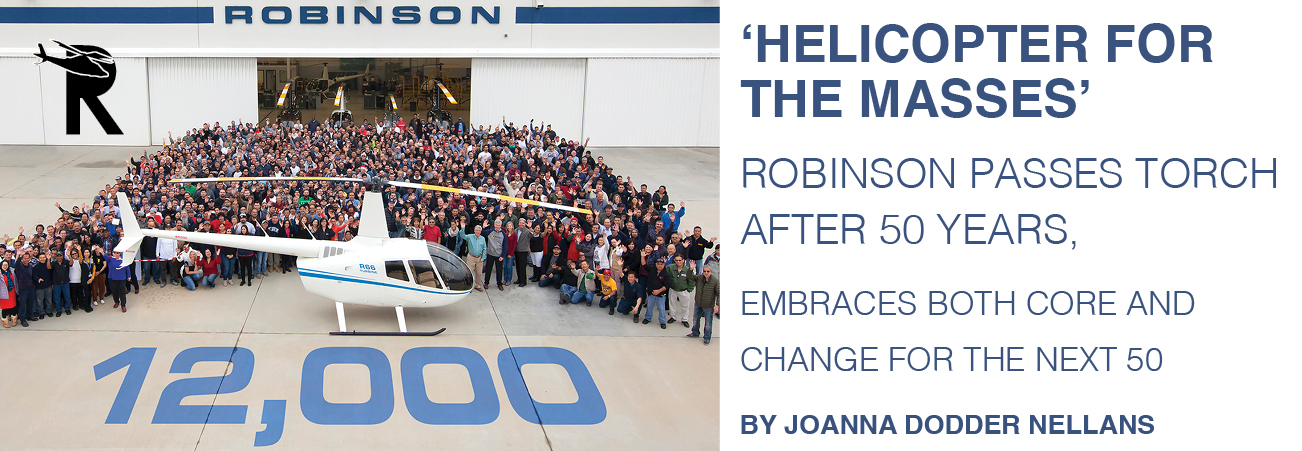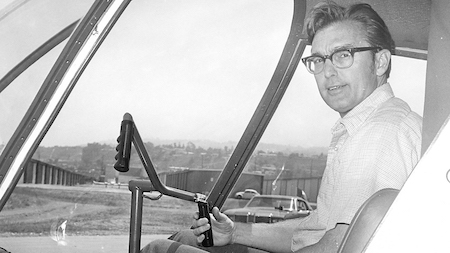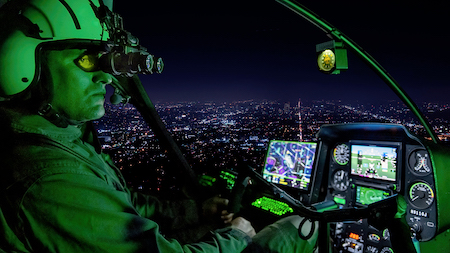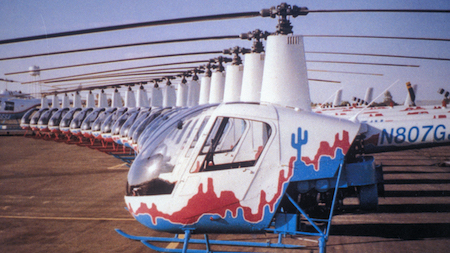|
May
20
2024
|
|
Posted 1 years 237 days ago ago by Admin
|
|

When Bell wanted to compete directly with the Robinson Helicopter Company, leadership assigned David Smith to be chief engineer for the development of the Bell 505. The first thing Smith did was lease a Robinson R66 for his team to analyze.
"I told them, 'You need to know the enemy,'" Smith recalled. Bell's old guard had mocked the Robinson helicopter as a "toy for the rich guys," but Smith's team quickly realized it was much, much more.
"When we took it apart and studied it, it was quite the opposite," Smith related. "It was ruthlessly efficient. As an engineer, I could appreciate the thousands and thousands of decisions they made that got the product to this highly evolved state."
The 505 Jet Ranger X project was completed early and $10 million under budget under Smith's leadership. Now a decade later, Smith is Robinson's new leader after serving as its VP of operations for the past year.
Smith has big shoes to fill as the company's first president/CEO whose last name is not Robinson, since Frank Robinson and then his son Kurt ran the company for the first half-century of its existence. However, Smith has plenty of pedigree of his own with an aerospace engineering degree from MIT and more than 20 years of experience in aviation and rotorcraft. He spent most of his career at Bell Flight in multiple leadership roles across engineering, serving as program director for critical product developments as well as the vice president of operations modernization. Smith also led TRU Simulation + Training Inc., an affiliate of Textron Aviation, delivering pilot training solutions that include full-flight simulators and flight training devices.

In 1973, then 43-year-old Frank Robinson sits in the cokcpit of Robinson R22, Serial #0001. Photo - Robinson Helicopter
Helicopter for the Masses
As Kurt Robinson likes to put it, the original R22 is a "helicopter for the masses."
"Its popularity was the thing that probably gave it that moniker more than anything else," Robinson said.
His father, Frank, set out to create a small personal helicopter. Reaching the market in 1979 for only $40,000, it quickly became popular with private operators and opened up the world of training to more people. Its speed and agility also made it a hit with cattle herders in the U.S., Australia and New Zealand.
"You can really make those aircraft dance," said Robinson, who has piloted plenty of them. That attribute makes the R22 a preferred choice for freestyling at the World Helicopter Championships, he added.
When people told him they wanted a flying "family car," Frank Robinson designed the four-seat R44. Now the R66 is having its spotlight and proving that Robinson isn't attached to a single motor type. More than 13,000 Robinsons are now in the air.
Smith describes Robinson's common goal this way: "Make them easy to support, make them simple to operate and make them robust for hard missions."
Kurt Robinson Transitions
Kurt grew up watching his father Frank leave his Hughes Tool Company engineering job to create his own company in 1973 and design the R22 at home. Kurt helped launch the R22, earned his MBA and law degree, got his pilot's license, and became his father's right-hand man at Robinson as the company developed the R44 and R66. With FAA certification of the R66 imminent, Frank retired in 2010 and passed leadership to his son. The founding father passed away in 2022.
Feeling it's time to pass the leadership back to an engineer, Kurt Robinson is transitioning to an advisory role while remaining on the board of directors. With more than 450 service centers around the world, Robinson said he'd like to visit more of them now that he will have more available time on his hands.
Robinson also looks forward to fixing up his family home on Whidbey Island in the Puget Sound north of Seattle. Some of his favorite memories with his father include flying along the West Coast to the island, where their family has owned a home since 1916. The views while flying low along the coast are stunning, he related. Before Kurt got his own pilot's license, he loved having his dad pick him up in the UC-San Diego parking lot to carry him home for the holidays, to the astonishment of his friends.

In 2022, the R66 NVG/Police cockpit is FAA Certified. Photo - Robinson Helicopter
Safety Legacy
During a press briefing at this year's HAI Heli-Expo announcing the major leadership change at Robinson, an audience member praised Kurt for his "brilliant" leadership that included numerous safety improvements; that recognition prompted loud applause from the audience.
Safety has always been in the forefront for Robinson, Kurt said. Operators often were surprised to find Frank Robinson himself teaching part of the RHC safety course. You can still find online videos of Frank emphasizing the need to fly above 500 AGL (or 1,000 AGL in noise-sensitive areas).
Major recent safety advances for operators include bladder fuel tanks, windshields built to better withstand bird strikes, 4K camera systems, and symmetrical stabilizers. The symmetrical stabilizer is now standard on all R66 and R44 models, and at-cost retrofit kits are available for older models. The stabilizer improves handling during high-speed flight and turbulence.
For a year preceding his appointment as leader, Smith was tasked with increasing employee safety during the manufacturing process. He's been focusing on reducing repetitive motion injuries, and this year Robinson will add robotic cells that can offer employees relief from the most tedious tasks such as sanding and polishing.
It's important to give employees the resources and training they need, Smith added.
"Our job as leaders is to make our employees safe, successful and efficient," he said.
Smith has enjoyed the opportunity to work closely with Kurt Robinson on processes and procedures for the past year. "I've got 50 years of history to absorb," he noted.

In 1988, RHC became the world's leading producer of helicopters. Photo - Robinson Helicopter
Reducing Backlog
Before it can expand its market, Robinson needs to get on top of a backlog of existing orders.
Despite supplier constraints, Robinson already increased production in 2023 by delivering 296 helicopters compared to 258 the previous year, Kurt Robinson said. About two-thirds were exported, with leading export countries including Brazil, Australia, Canada and Mexico.
Even more production is needed as Robinson faces a backlog that results in sold-out conditions until the end of Q2 2024.
Robinson is dealing with this backlog by hiring more engineers and factory employees, instilling better production methods, adding manufacturing space at its home base in Torrance, California, and working closely with engine manufacturers Rolls-Royce and Lycoming on supply issues. Overall staffing has increased from approximately 1,000 to nearly 1,300 to help relieve backlog and grow beyond it.
Smith hopes the company can produce 350 helicopters this year.
Ramping Up Sales and Marketing
If you're going to grow your customer base, you need to let potential customers know about your products.
So as Frank Robinson's daughter, Terry Hane, retired in December, Robinson hired Robyn Eagles as the head of global marketing and communications. The new word "global" in her title shows Robinson plans a global campaign. Throughout her career, Eagles developed innovative strategies for Kelley Blue Book, Honda, Acura, TuSimple, and Skyryse to spur growth, awareness and market dominance.
Eagles is overseeing production of the new "Climb Higher" video series featured on the Robinson website and YouTube channel. The series highlights how customers and operators around the world use Robinson helicopters for their missions.
"Our business is built off thousands of small businesses," Smith noted.

Episode one features Quantum Helicopters based in Chandler, Arizona. The company has trained approximately 4,000 pilots over its 31-year history.
"The reliability of the R22 in my experience is just unmatched," Quantum founder and president Neil Jones tells viewers. He loves the 2,200-hour systemic overhaul schedule.
"The R22 is the platform to train an entire generation of pilots," Eagles said. "It revolutionized civil aviation."
New Products on the Way
This is a pivotal time in the helicopter industry as new tech threatens to change the paradigm of traditional ops. Compared to start-ups, Robinson has a head start on innovative advances with its existing helicopters, widespread customer base and certification knowledge, Smith said.
For Robinson, product advancement doesn't necessarily mean high-tech software or powerplants.
For example, the company is working on unleaded fuel improvements. The R22 and R44 Raven I and R44 Cadet all operate on 91UL or 94UL. Robinson is coordinating with Lycoming and fuel manufacturers on a solution for the R44 Raven II.
Decreasing rotor noise is a bit trickier, but Robinson's 50% increase in its engineering staff aims to improve on that too.
The latest version of the Robinson helicopter, the R66, has been out for a decade now, and Robinson is listening to the market about what's next, Kurt Robinson said. While the company is somewhat secretive about its next helicopter version, Smith has hinted that this could be the perfect time to develop a new model akin to a lighter Huey or Llama that's easy to support in the field. He says it will be a "rugged, reliable, dependable aircraft" that will attract customers in underserved areas of the world, such as India.
"Our sweet spot is areas of the world that lack infrastructure, lack reliable supply chains, and need durable, reliable and easy field-repairable systems and service," Smith says, "and I think we can bring Robinson affordability to more sophisticated applications.
"The future is going to have elements of enhanced operational technologies like machine vision that will help to identify threats before the pilot has time to perceive and react to them. So the systems will protect the pilot more than they do today, but I also think we'll still have pilots that love to fly and want a conventional interface with the aircraft."
One area of growth Smith isn't pursuing is the military market. He's been there with Bell and understands that produces a substantial increase in costs.
Robinson leaders are proud to say their people have produced the largest fleet of helicopters in the world that's originally built for the civilian market.

The original instrument display for the Robinson R22, Serial #0001. Photo - Robinson Helicopter
Technology Partnerships
Robinson doesn't shy away from the high-tech stuff. The company has already joined in tech-forward partnerships with Tier 1 Engineering, Skyryse and Rotor Technologies, for example. Robinson provides the workhorse platform that gives these projects a head start.
Tier 1 Engineering completed its first electric-powered flight between airfields in October with a modified R44 featuring a MagniX electric motor. Electrification will be a major factor in reducing helicopter noise, Smith noted.
Skyryse is already taking reservations for its first production helicopter equipped with its automated flight control system. Dubbed Skyryse One, it's an R66 modified with one four-axis control stick and two touchscreens in place of all the mechanical switches and gauges. A simple touchscreen swipe starts the engine and it hovers on command. The initial sale price is $1.8 million.
Rotor Technologies already completed its first uncrewed flight test of a full-scale civilian rotorcraft in November with the R220Y, an experimental platform based on the Robinson R22.
"No other company is close to performing commercial operations with an autonomous helicopter of this size," Rotor Technologies Chief Commercial Officer Ben Frank said.
Rotor Technologies is now commercializing its technology with the R550X that builds off Robinson's R44 Raven II. The R550X is designed to perform hazardous operations such as firefighting, crop dusting, construction, humanitarian aid, and remote cargo delivery without putting pilot lives at risk.
Rotor Technologies plans to certify the technology for passenger flight – thereby bringing Kurt Robinson's motto of "Helicopter for the Masses" to a whole new potential with faster and affordable commutes for middle-class passengers.
“We believe that our flight heritage and manufacturing capability will position Robinson to be a key player in the next generation of VTOL aviation," Smith said. "You can be certain that Robinson will be in the middle of the future of aviation."
READ MORE ROTOR PRO: https://justhelicopters.com/Magazine
WATCH ROTOR PRO YOUTUBE CHANNEL: https://buff.ly/3Md0T3y
You can also find us on
Instagram - https://www.instagram.com/rotorpro1
Facebook - https://www.facebook.com/rotorpro1
Twitter - https://twitter.com/justhelicopters
LinkedIn - https://www.linkedin.com/company/rotorpro1